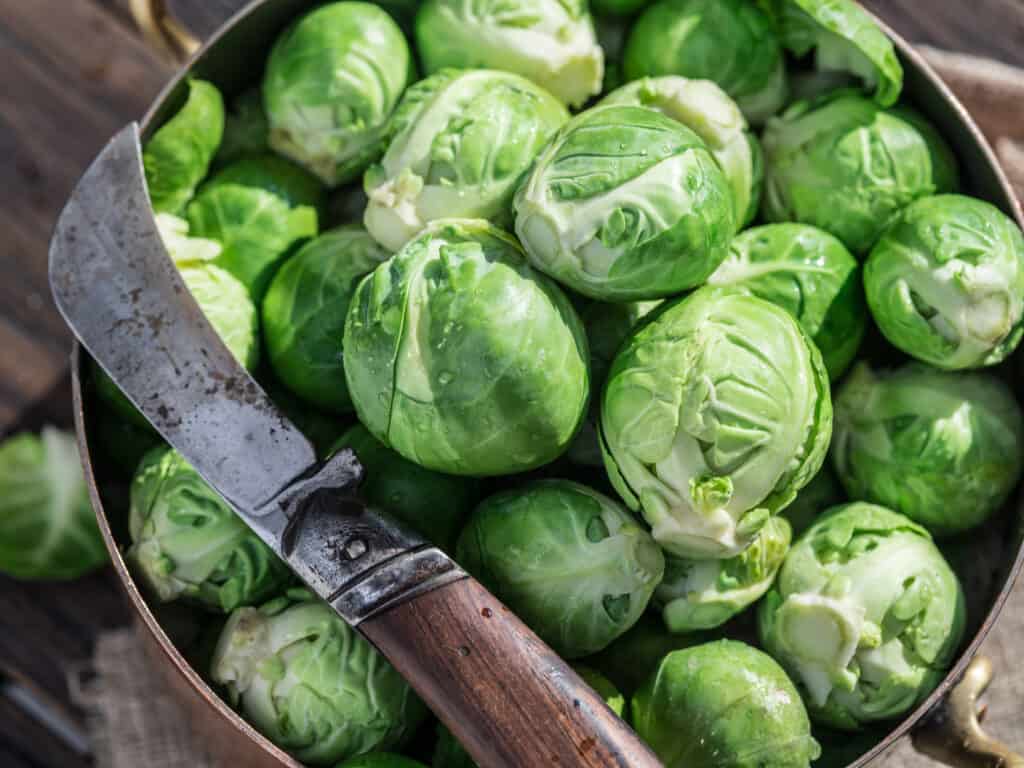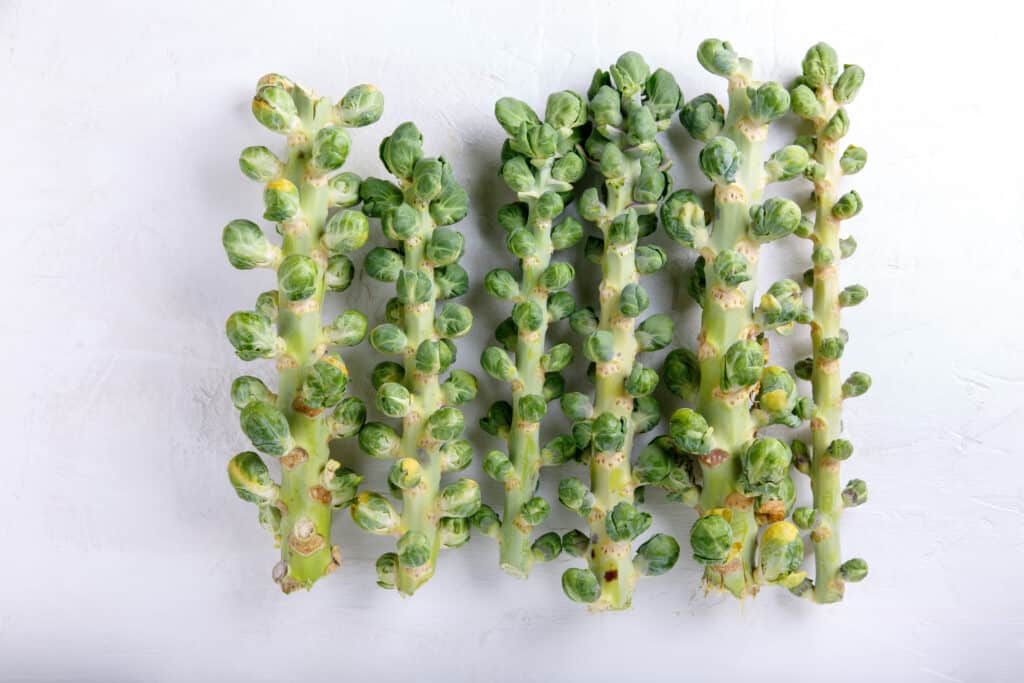Harvest Brussels sprouts when they are ½ to 1¾ inches (1-4 cm) in diameter, green, and firm.
Brussels sprouts are ready for harvest 90 to 110 days after sowing.
Related articles:

When to harvest Brussels sprouts
- Start picking after the first frost and continue into early winter in cold-winter regions. Sprouts become sweeter and more flavorful after they’ve been touched by frost. Sprouts can be harvested from beneath the snow.
- In mild-winter regions, Brussels sprouts planted in late summer or fall can be harvested all winter.
- During harvest pick off soft and undersized sprouts even if you don’t plan to eat them; also remove leaves below the sprouts you’ve picked; this will keep the plant growing tall and producing new sprouts.
- A single plant will produce about 100 sprouts over 2 to 3 months. Sprouts left on the plant for too long will start to yellow and the tightly wrapped leaves will loosen.
- Plants will produce quickly at first but as the weather gets colder and colder production will slow. Fully mature sprouts can remain on the plant in cold weather; harvest sprouts as you need them.
- To protect plants from hard freezes, bury them up to their top leaves in straw and pull back the straw as you want to harvest. If temperatures drop consistently below 20°F (-6°C), complete the harvest and store the sprouts.
Kitchen Helpers from Amazon:
- Oster Vegetable Steamer
- Chef’s Knives Set of 6
- EZ Off Jar Opener for Weak Hands
- Pepper Core Remover Stainless Steel
- Kitchen Utensils – Set of 35
- Rachel Ray Non-Stick Cookware 12pcs
How to harvest Brussels sprouts
- Harvest sprouts by beginning at the bottom of the plant and picking off sprouts that are about the size of a marble or larger. Continue the harvest by moving up the stalk.
- Sprouts grow at the base of each leaf close to the plant’s main stem. Grasp each sprout with two fingers and simply give a twist to pull it away or use garden scissors, but don’t cut too close to the stem.
- If you want to harvest most of the sprouts on a plant at once, wait until the lower sprouts are about ½ inch in diameter then cut off the top of the plant about two weeks before you want to harvest.
- Removing the top leaves and the growing tip will direct the plant’s energy into maturing sprouts.

How to store Brussels sprouts
- Store Brussels sprouts cold and moist, 32°-40°F (0°-4°C) and 95 percent relative humidity. Cold and moist storage is a challenge. Refrigerators provide the cold, but they also dry the air.
- Store sprouts unwashed and wrapped in a moist towel in a perforated plastic bag in the vegetable crisper section of the refrigerator. Refrigerated sprouts will keep for 3 to 5 weeks.
- You can store sprouts individually or attached to the whole stalk. If you store the whole stalk, wrap a moist paper towel around the stub to extend storage.
- In very cold winter areas, you can dig up some of the plants and move them into a cold frame or into containers in a cool garage or basement. You can harvest sprouts from these plants for several months.
- Leaves from the Brussels sprouts plant are edible but they are thicker and tougher than cabbage so they are best chopped and steamed for serving.
Brussels sprouts articles at Harvest to Table:
How to Plant and Grow Brussels Sprouts
Brussels Sprouts Seed Starting Tips
How to Harvest and Store Brussels Sprouts
Brussels Sprouts Growing Problems: Troubleshooting
Five Easy Ways to Cook and Serve Brussels Sprouts
Garden Planning Books at Amazon:
- Vegetable Garden Almanac & Planner
- Kitchen Garden Grower’s Guide Vegetable Encyclopedia
- Vegetable Garden Grower’s Guide
- Tomato Grower’s Answer Book
More harvest tips:
Learn when and how to harvest your favorite vegetables for the best flavor and texture. Get storage tips for each crop. Click on the vegetable you are growing below.
- Artichoke
- Arugula
- Asparagus
- Beans
- Beets
- Broccoli
- Brussels Sprouts
- Cabbage
- Cantaloupe — Melons
- Carrots
- Cauliflower
- Celery
- Chard
- Collards
- Corn, Sweet
- Cucumbers
- Eggplant
- Endive and Escarole
- Garlic
- Jerusalem Artichoke
- Kale
- Kohlrabi
- Leeks
- Lettuce
- Melons
- Okra
- Onions
- Parsnips
- Peas
- Peppers
- Potatoes
- Pumpkins
- Radicchio
- Rhubarb
- Rutabaga
- Spinach
- Squash, Summer
- Squash, Winter
- Sunchokes
- Sweet Potato
- Swiss Chard
- Tomatillo
- Tomatoes
- Turnips
- Watermelon















